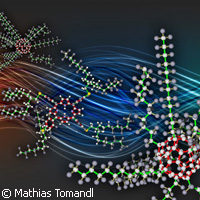Scientists push quantum mechanics closer to the everyday world
Proof of the quantum wave nature of large organic molecules has been reported in the journal Nature Communications by an international team of physicists. The findings may be a step towards reducing quantum interference on a bigger scale than previously achieved. Quantum interference, whereby individual particles in wave form cross their own trajectory and interfere with the direction in which they are travelling, is one of the most challenging concepts in quantum theory. Improving the understanding of such principles is of value in the field of quantum information science, which has applications in quantum computing. Just like light, matter exhibits both wave and particle properties under the right circumstances. However, massive objects exhibit very small wavelengths, so small in fact that it's rather pointless to think of them in a wave fashion. But for some objects, the wavelength can be observable and significant, as attested by double slit experiments with electrons. Markus Arndt from the University of Vienna in Austria and his colleagues observed quantum waves in synthetic organic molecules composed of up to 430 atoms. They demonstrate that, in massive molecular complexes with more than 1,000 internal degrees of freedom, quantum coherence, enabling stationary interference, can be accomplished. These organic molecules were comparable in size and complexity to insulin molecules and exhibited many features of classical objects. Nevertheless, in the experiment that was a simplified version of the concept of Shrödinger's cat, they could exist not so much as objects than as mists of possibilities of being here and there and everywhere at the same time. And when scientists looked at them, the possibilities collapsed to definitive positions. Just as Shrödinger's cat placed in a sealed box is neither alive nor dead but a ghostly mix of the two possibilities, one does not know which is true without looking. The significance of the wave particle duality is that all the behaviour of matter can be explained through the use of a differential equation that represents a wave function: Shrödinger's equation. This ability to describe reality in the form of waves is at the heart of quantum mechanics. While the mathematics, though complicated, results in accurate predictions, the physical meaning of these equations is much harder to grasp. The attempt to explain what the wave particle duality 'actually means' is still a key point of debate in quantum physics. Furthermore, the question remains: how far can we push this? The paper concludes by saying that these findings 'open a new window for quantum experiments with nanoparticles in a complexity class comparable to that of small proteins, and demonstrate that it is feasible to create and maintain high quantum coherence with [complex] thermal systems.'For more information, please visit: Universität Wienhttp://www.univie.ac.at/en/Nature Communicationshttp://www.nature.com/ncomms/index.html
Countries
Austria, Switzerland, Germany, United States



